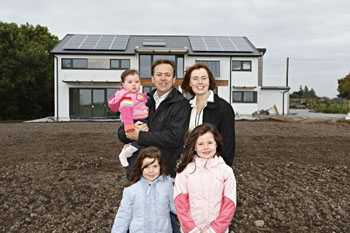Ireland’s first carbon negative house, the ileeid house in Co Westmeath, yesterday became energy positive for the second year running, having produced more energy than it used, resulting in a net surplus of energy and an overall carbon negative rating.
Designed and built by technologist and energy specialist Patrick Daly, the house is located near Mullingar and features a super insulated and airtight timber frame construction. Daly started building the house in February 2008 and moved into it in September 2009 with his wife and their three children.
The house was named ‘ileeid’, which means ‘integrated low energy and environmental impact design, says Daly. It is also believed to be Ireland’s first carbon negative house.
Most of the ileeid’s heating comes from the sun, either directly or indirectly. Back-up heating is provided by a small, ground sourced heat pump via a heat exchanger into the air supply system and this heat pump also provides back-up hot water in tandem with the solar water heating.
The Sustainable Energy Authority of Ireland (SEAI), under its Low Carbon Housing Programme for new builds (now suspended) supported the project. The Better Energy Homes Scheme at SEAI is its replacement scheme for people who wish to improve the energy performance of their homes and lower their energy costs in the long term. The incentive to homeowners comes in the form of a cash grant.
Daly says he started out with a vision to build an environmentally friendly ‘eco house’.
“In the early design stages, I focused on ensuring that the house had good passive solar features balanced with a rurally sensitive design. As the technical design progressed, I began to examine the possibility of zero energy as a target and felt confident that it could be achieved,” he explains.
“In essence, the house used passive house principles and targets to achieve an ultra-low space-heating demand. I then sought to radically reduce the remaining energy loads through additional energy-efficiency measures and to meet them from renewable sources.”

Patrick Daly and his family outside ‘ileeid’, their carbon negative house
The annual energy demand of the house is produced by a bank of 40 solar photovoltaic (PV) panels on its south-facing roof. In the winter, these produce a portion of the house’s energy demand, while in the summer they produce an excess – thus balancing out on an annual basis, according to Daly.
“The southerly roof has two banks of 20 180Wp monocrystalline PV panels giving a theoretical peak output of 7kW in the Irish context, supplied and fitted by Carey Glass Solar.”
Surplus electricity sold back to Irish grid
The surplus energy produced at Daly’s house is being sold back to the Irish electricity grid.
Explains Daly: “Depending on extent of solar radiation, the house is either importing or exporting electricity. The electricity we generate we sell back to the grid, at a poor rate compared to other EU countries, but it is close to what we are charged per unit, so effectively we export a similar amount of energy as we import. Thus our energy bill is very low – only the standing charge for the service, really.”
He says he designed the house to exceed the German Passive House standard with a space-heating demand of less than 15kWh/m2 per year.
Daly’s BESRAC consultancy has also won a number of awards for the house’s design, most notably the 2010 SEAI annual energy award in the ‘Sustainable Energy in the Built Environment’ category and the 2011 Green Awards in the ‘Green Residential Building’ category.
Eco housing projects in Donegal and Athlone
Daly has also consulted on two other housing projects that are aiming to become energy positive.
“One house is in Donegal, which is a refurbishment, and with a better wind turbine it should achieve energy positive, and the other is a zero-carbon house (not the same as energy positive) near Athlone. I am currently designing two zero-energy houses in the midlands.”
Meanwhile, the eco village in Cloughjordan, Co Tipperary, is also pioneering low-energy houses, aiming to become Ireland’s first eco village, despite the downturn in the construction industry.
Other green aspects of the ileeid house
Daly also integrated a bespoke waste water heat recovery system into his house.
“The system utilises the heat pump to extract waste heat from a warm grey water tank collected from showers and the washing machine, etc.”
The system can also dump excess solar heat into the ground array for later use via the the heat pump to extract excess heat from the hot-water cylinder and transfer it to the ground collector.
Low-embodied energy and carbon materials were also used during the build, where possible, affirms Daly. Carbon sequestration materials (ie, materials that store or have carbon locked within, such as wood and earth) were also used.
“The earth floor has proved to be an excellent material and has great carbon-saving potential, as well as providing excellent thermal mass. Earth was also used as an infill material in some of the internal walls to add mass, which is proving effective in terms of limiting temperature swings,” he adds.